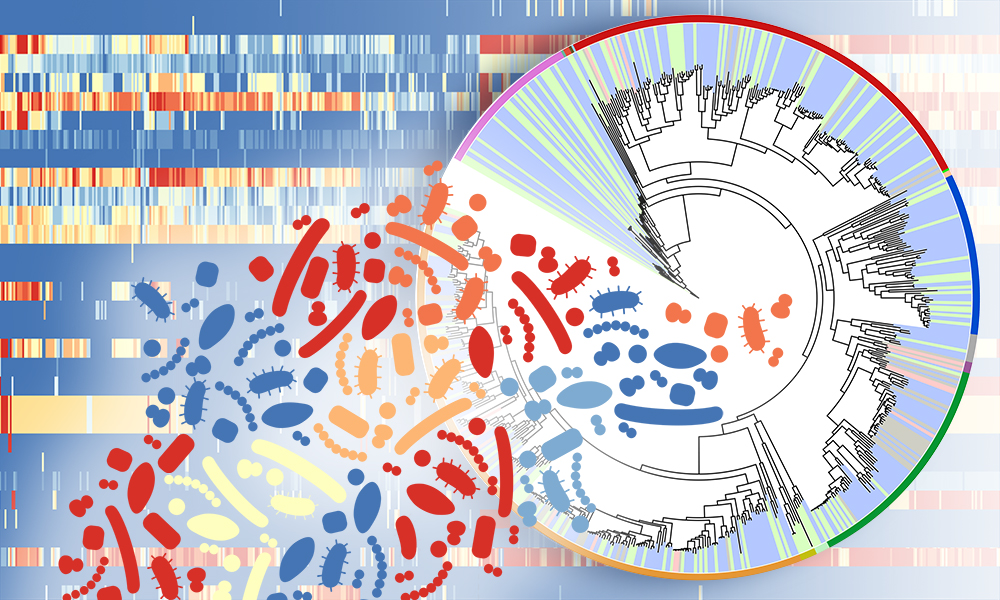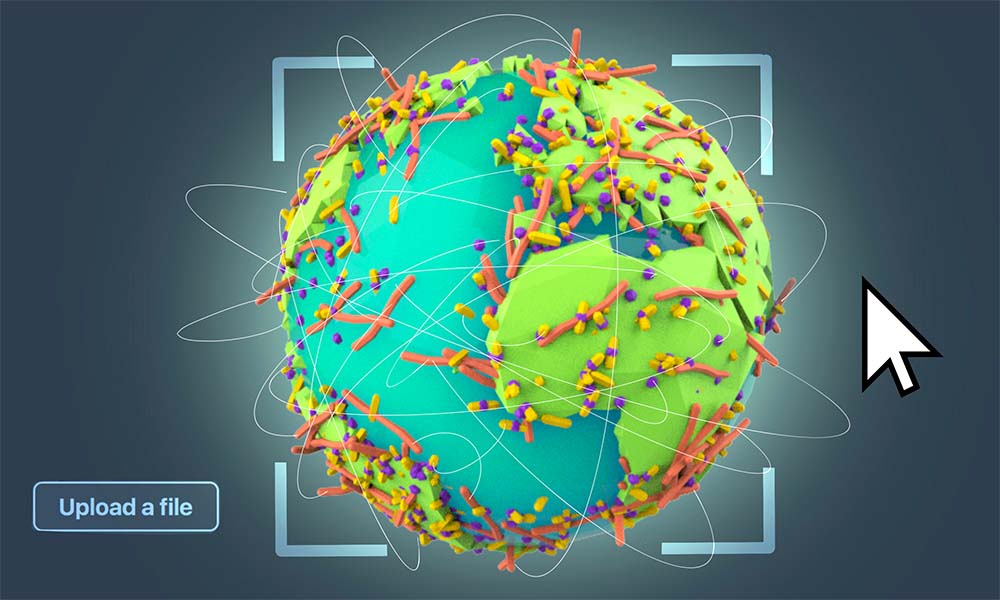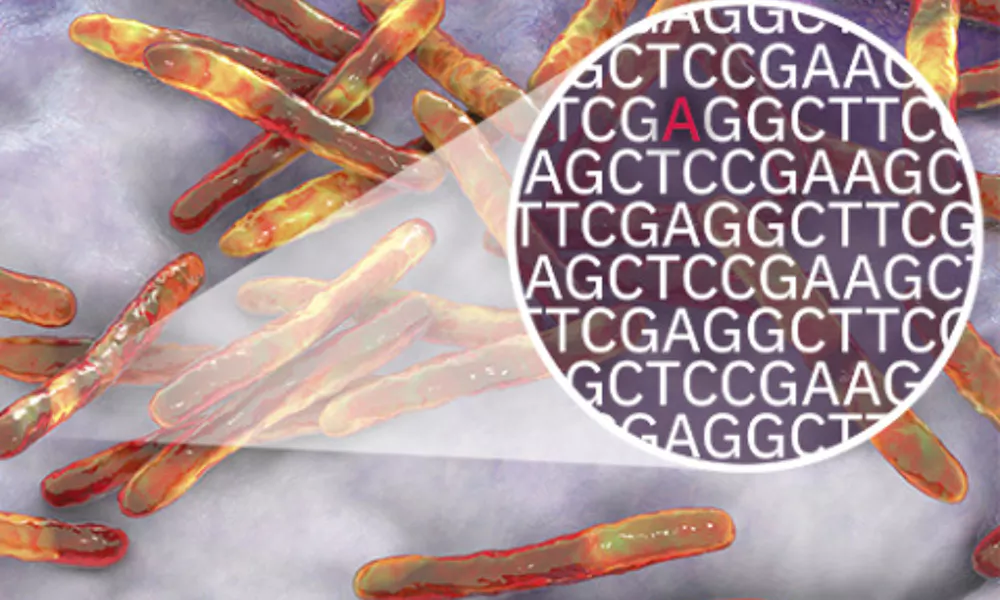 Edit
Edit
Mapping microbiomes: the power of microbial communities
EMBL research aids understanding of microbial communities and their interconnection with human and planetary health.

Communities of microbes, known as microbiomes, are being increasingly studied by researchers around the world. EMBL researchers are contributing to this effort by characterising and analysing diverse microbial ecosystems, as well as offering automated analysis pipelines and archiving microbiome data.
In 2021, EMBL-EBI and collaborators in the United States, Germany, and the United Kingdom sequenced the genomes of microorganisms detected within 594 samples taken from various skin surfaces of 12 healthy volunteers. From this data, they created the Skin Microbial Genome Collection (SMGC) – a collection of reference genomes for the human skin microbiome. The collection includes 174 previously unknown bacterial species, four new eukaryotes, and 20 new jumbo phages – viruses with a genome larger than 200 kilobases. This study singlehandedly expanded the catalogue of known skin bacteria by 26 %. All of these data will be made freely accessible as a new genome catalogue in the MGnify data resource, where researchers can find a huge range of microbiome datasets including those for the human gut.
A previous study from the Patil and Bork groups used advanced metabolic modelling with data from thousands of microbial communities across the globe to understand microbial relationships. They learned groups of cohabitating bacteria tend to be either highly competitive or highly cooperative, seemingly determined by survival advantages. For this, they used data from the Earth Microbiome Project (EMP), a massively collaborative effort to characterise microbial life on the planet.
In another study, the Bork group and collaborators launched the Global Microbial Gene Catalog. With more than 2 billion genes, identified from samples collected from 14 different environments, the catalogue helps with comparative analyses of genetic features of myriad microbiomes. Researchers can explore how specific functionalities emerge, develop, and spread in these various microbial worlds.

Microbial communities are not only an integral part of ecosystems surrounding us, they also are central to health and disease. As part of another international collaboration, EMBL-EBI is hosting and making freely available a database needed to effectively study drug resistance in tuberculosis. The Comprehensive Resistance Prediction for Tuberculosis: an International Consortium (CRyPTIC) aims to find the causes of drug resistance in bacteria that cause tuberculosis and enable rapid diagnostics that could radically improve future tuberculosis treatments.

These studies capture the genomic, taxonomic, and physiological diversity of the microbiomes surrounding us everywhere. More importantly, as they expand, they significantly add to the biologist’s toolkit for studying life ‘in context’.
 Edit
Edit
“MGnify is just one of many open access databases developed at EMBL helping to make our data freely available to others to unravel links between microbial communities, human health, and disease.”
— Rob Finn, Team Leader, Microbiome Informatics, EMBL-EBI

“From funnels and bottles to pipettes and safety glasses, the items on my long inventory list guarantee we meet our scientists’ basic needs to keep their projects going.”
— Flavio Zizzo, Purchase Officer, EMBL Rome

“It’s motivating to wake up each day knowing our work here contributes to scientific outcomes that make a difference for a promising future around the globe.”
— Stefan Debast, Head of Finance, EMBL
Explore more 2021 EMBL microbiome research highlights:
References
Kashaf SS et al. (2021). Integrating cultivation and metagenomics for a multi-kingdom view of skin microbiome diversity and functions. Nature Microbiology, 24 December 2021. DOI: 10.1038/s41564-021-01011-w
Blasche S et al. (2021). Metabolic cooperation and spatiotemporal niche partitioning in a kefir microbial community. Nature Microbiology, 4 January 2021. DOI: 10.1038/S41564-020-00816-5
Machado D et al. (2021). Polarization of microbial communities between competitive and cooperative metabolism. Nature Ecology and Evolution, 4 January 2021. DOI: 10.1038/s41559-020-01353-4
Coelho LP et al. (2021). Towards the biogeography of prokaryotic genes. Nature, 15 December 2021. DOI 10.1038/s41586-021-04233-4
Walker TM et al. (2022). The 2021 WHO catalogue of Mycobacterium tuberculosis complex mutations associated with drug resistance: a genotypic analysis. Lancet Microbe, 8 March 2022. DOI: 10.1016/S2666-5247(21)00301-3
The Cryptic Consortium. (2021). Genome-wide association studies of global Mycobacterium tuberculosis resistance to thirteen antimicrobials in 10,228 genomes. bioRxiv, 16 September 2021. DOI: 10.1101/2021.09.14.460272
The Cryptic Consortium. (2021). A generalisable approach to drug susceptibility prediction for M. Tuberculosis using machine learning and whole-genome sequencing. bioRxiv, 16 September 2021. DOI: 10.1101/2021.09.14.458035
The Cryptic Consortium. (2021) Quantitative measurement of antibiotic resistance in Mycobacterium tuberculosis reveals genetic determinants of resistance and susceptibility in a target gene approach. bioRxiv, 16 September 2021. DOI: 10.1101/2021.09.14.460353
The Cryptic Consortium. (2021). Epidemiological cutoff values for a 96-well broth microdilution plate for high-throughput research antibiotic susceptibility testing of M. tuberculosis. medRxiv, 16 September 2021. DOI: 10.1101/2021.02.24.21252386
Brankin A, Malone K et al. (2021). A data compendium of Mycobacterium tuberculosis antibiotic resistance. bioRxiv, 16 September 2021. DOI: 10.1101/2021.09.14.460274
Fowler PW et al. (2021). BashTheBug: a crowd of volunteers reproducibly and accurately measure the minimum inhibitory concentrations of 13 antitubercular drugs from photographs of 96-well broth microdilution plates. bioRxiv, 13 September 2021. DOI: 10.1101/2021.07.20.453060
Hunt M et al. (2021). Minos: variant adjudication and joint genotyping of cohorts of bacterial genomes. bioRxiv, 15 September 2021. DOI: 10.1101/2021.09.15.460475

